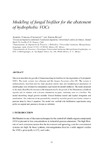Mostrar o rexistro simple do ítem
Modeling of fungal biofilter for the abatement of hydropic VOCs
| dc.contributor.author | Vregara Fernández, Alberto | es_ES |
| dc.contributor.author | Revah, Sergio | es_ES |
| dc.date.accessioned | 2014-10-01T10:17:08Z | |
| dc.date.available | 2014-10-01T10:17:08Z | |
| dc.date.issued | 2007 | es_ES |
| dc.identifier.citation | Biotechniques for Air Pollution Control II, 2007: 95-106. ISBN: 978-84-9749-258-4 | es_ES |
| dc.identifier.isbn | 978-84-9749-258-4 | es_ES |
| dc.identifier.uri | http://hdl.handle.net/2183/12863 | |
| dc.description.abstract | [Abstract] This work describes the growth of filamentous fungi in biofilters for the degradation of hydrophobic VOCs. The study system was n-hexane and the fungus Fusarium solani B1. The system is mathematically described and the main physical, kinetic data and morphological parameters of aerial hyphae were obtained by independent experiments for model validation. The model proposed in this study describes the increase in the transport area by the growth of the filamentous cylindrical mycelia and its relation with n-hexane elimination in quasi -stationary state in a biofilter. The model describing fungal growth includes Monod-Haldane kinetic and hyphal elongation and ramification. The reduction in the permeability caused by mycelial growth was further related to pressure drop by Darcy’s equation. The model was verified with biofiltration experiments using perlite as support and gaseous n-hexane as substrate. | es_ES |
| dc.language.iso | eng | es_ES |
| dc.publisher | Universidade da Coruña | es_ES |
| dc.title | Modeling of fungal biofilter for the abatement of hydropic VOCs | es_ES |
| dc.type | info:eu-repo/semantics/conferenceObject | es_ES |
| dc.rights.access | info:eu-repo/semantics/openAccess | es_ES |






